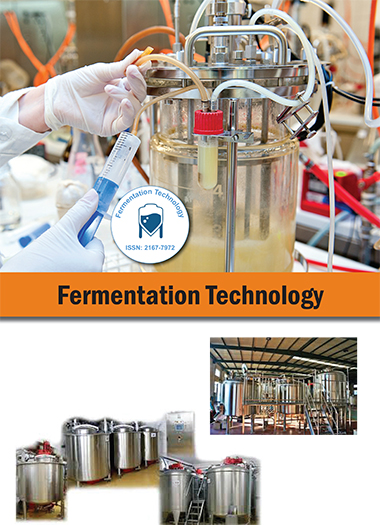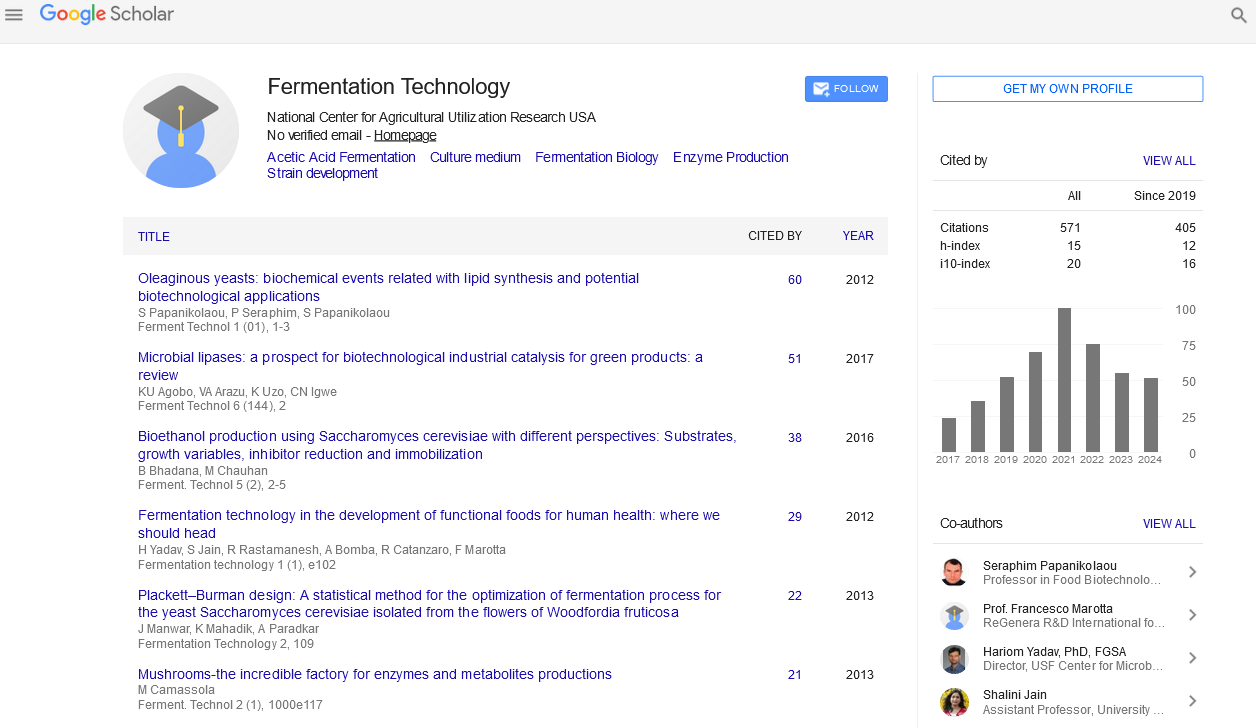Indexed In
- Open J Gate
- Genamics JournalSeek
- Access to Global Online Research in Agriculture (AGORA)
- RefSeek
- Hamdard University
- EBSCO A-Z
- OCLC- WorldCat
- Publons
Useful Links
Share This Page
Journal Flyer

Open Access Journals
- Agri and Aquaculture
- Biochemistry
- Bioinformatics & Systems Biology
- Business & Management
- Chemistry
- Clinical Sciences
- Engineering
- Food & Nutrition
- General Science
- Genetics & Molecular Biology
- Immunology & Microbiology
- Medical Sciences
- Neuroscience & Psychology
- Nursing & Health Care
- Pharmaceutical Sciences
Commentary - (2023) Volume 12, Issue 1
Unlocking the Science of Ethanol Fermentation: From Alcoholic Beverages to Sustainable Biofuels
Mia Thomas*Received: 03-Mar-2023, Manuscript No. FMT-23-20920; Editor assigned: 06-Mar-2023, Pre QC No. FMT-23-20920(PQ); Reviewed: 21-Mar-2023, QC No. FMT-23-20920; Revised: 28-Mar-2023, Manuscript No. FMT-23-20920(R); Published: 07-Apr-2023, DOI: 10.4172/2167-7972.23.12.163
Description
Ethanol fermentation is a biological process that has been used for thousands of years to produce alcoholic beverages such as beer and wine. It is also a key process in the production of biofuels, which are an important alternative to fossil fuels. In this article, we will explore the science behind ethanol fermentation, its applications, and its potential as a sustainable source of energy. Ethanol fermentation is a process that occurs when yeasts or other microorganisms consume sugars and produce ethanol and carbon dioxide as waste products.
The overall chemical reactiom can be represented as follows
C6H12O6 → 2C2H5OH + 2CO2
Where C6H12O6 is a sugar molecule (such as glucose), and C2H5OH and CO2 are ethanol and carbon dioxide, respectively. The process of ethanol fermentation can be broken down into several steps:
Glycolysis: In this step, glucose is broken down into two molecules of pyruvate, which generates two molecules of ATP and two molecules of NADH.
Pyruvate decarboxylation: In this step, pyruvate is converted into acetaldehyde and CO2 by the enzyme pyruvate decarboxylase.
Alcohol fermentation: In this step, acetaldehyde is reduced to ethanol by the enzyme alcohol dehydrogenase, using NADH as a coenzyme.
The production of ethanol and CO2 during ethanol fermentation is responsible for the characteristic flavor and carbonation of alcoholic beverages such as beer and champagne. The microorganisms that are commonly used in ethanol fermentation include yeasts and bacteria. The most commonly used yeast species for ethanol production are Saccharomyces cerevisiae and Saccharomyces pastorianus. These species are favored for their ability to convert glucose into ethanol and their tolerance to high concentrations of ethanol. Other yeasts that have been used for ethanol fermentation include Candida albicans and Kluyveromyces marxianus. Bacteria such as Zymomonas mobilis and Clostridium thermocellum are also used for ethanol production.
Conditions for ethanol fermentation
The conditions required for ethanol fermentation depand on the specific microorganism being used. Some of the ket factors that affect the fermentation process include:
Temperature: Different microorganisms have different temperature requirements for optimal fermentation. For example, Saccharomyces cerevisiae ferments best at around 30° C-35°C, while Zymomonas mobilis prefers a temperature of around 35°C-38°C.
PH: Most microorganisms require a pH range of 4.0-5.5 for optimal fermentation. Maintaining the correct pH is important to ensure the growth and activity of the microorganisms.
Nutrient availability: Microorganisms require a range of nutrients to grow and carry out the fermentation process. These include nitrogen, phosphorus, and trace minerals.
Sugar concentration: The concentration of sugar in the fermentation medium can have a significant impact on the fermentation rate and yield. High concentrations of sugar can inhibit the growth and activity of the microorganisms.
Applications of ethanol fermentation: Ethanol fermentation has been used for thousands of years to produce beer, wine, and other alcoholic beverages.
Ethanol fermentation is a key process in the production of biofuels such as ethanol and butanol. These fuels are derived from plant-based sugars and can be used as an alternative to fossil fuels. Ethanol fermentation is used to produce a range.
Citation: Thomas M (2023) Unlocking the Science of Ethanol Fermentation: From Alcoholic Beverages to Sustainable Biofuels. Ferment Technol. 12:163.
Copyright: © 2023 Thomas M. This is an open-access article distributed under the terms of the Creative Commons Attribution License, which permits unrestricted use, distribution, and reproduction in any medium, provided the original author and source are credited.

